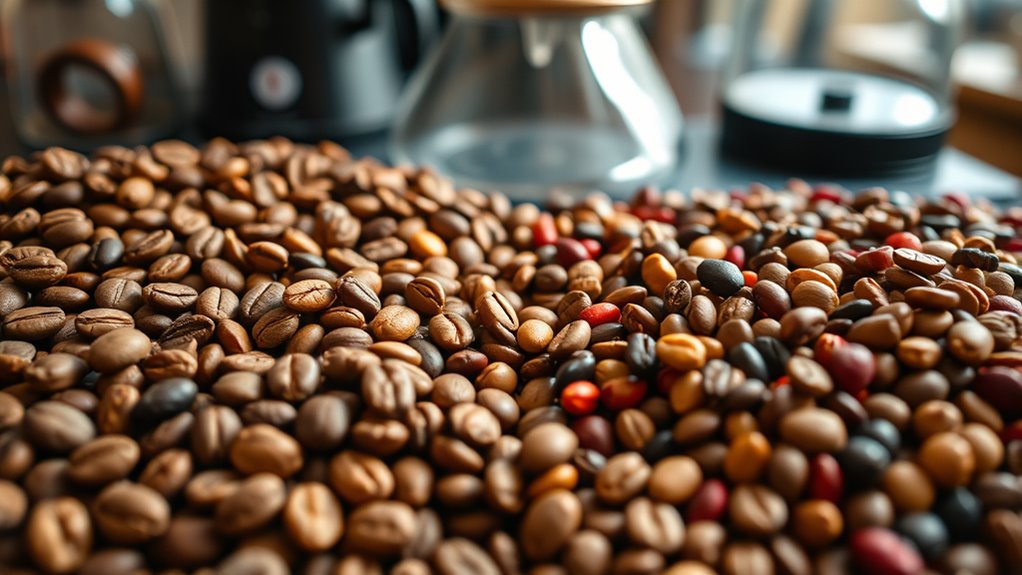Single-origin coffee comes from a specific farm or region, offering unique flavors like floral, fruity, or spicy notes that reflect local conditions. Blended coffee combines beans from multiple sources for a consistent, balanced taste, ideal for everyday use. If you prefer a distinctive experience with stories behind the beans, single-origin may suit you. For a predictable, smooth cup, blends work well. Keep exploring to discover how each choice shapes your coffee journey.
Key Takeaways
- Single-origin coffee comes from a specific farm or region, offering unique flavor profiles, while blended coffee combines beans from multiple sources for balance.
- Single-origin coffees often feature floral, fruity, or spicy notes that vary with harvest, whereas blends prioritize consistency and smoothness.
- High-end markets favor single-origin for its complex flavors and storytelling, whereas blends are popular for daily routines and affordability.
- Single-origin production emphasizes traceability, sustainability, and regional character, while blending focuses on maintaining flavor balance and uniformity.
- Choice depends on whether you seek a distinctive, region-specific experience or a reliable, well-rounded cup.

When choosing between single-origin and blended coffees, understanding their differences can considerably enhance your brewing experience. Single-origin coffee comes from a specific farm or region, offering you a unique flavor profile shaped by local growing conditions and processing methods. It’s prized for its complexity and nuances, which can vary markedly from one harvest to another. This variability makes each cup a distinctive experience, reflecting the terroir—characteristics of the land and climate—where the beans were cultivated. Because of this traceability, you can often learn the story behind the beans, adding a layer of appreciation to your coffee ritual.
Single-origin coffee offers unique flavors and stories from specific regions, making each cup a distinctive experience.
On the other hand, blended coffee combines beans from multiple farms or regions. The goal here is to create a balanced, consistent flavor that appeals to a broad audience. Blends are popular in commercial settings because they offer predictability and uniformity, making them ideal for cafes and large-scale production. They tend to be more accessible and affordable, appealing to consumers who prioritize reliability over uniqueness.
The flavor profiles of these coffees differ markedly. Single-origin coffees are often described as exotic, bold, and robust, thanks to their distinct growing environments. You might notice floral, fruity, or spicy notes that stand out with each brew. Since the flavor can change from harvest to harvest, each cup might surprise you with new nuances.
Conversely, blended coffees are crafted to harmonize different flavor elements, producing a well-rounded, balanced cup. This approach emphasizes consistency, which is why many people prefer blends for their daily routines. Blends are also more forgiving during brewing—they tend to handle slight variations in water ratio or temperature better, making them easier for home brewers to master. They’re especially common for espresso, as their balanced nature lends itself well to the intense extraction process.
Market trends show a rising interest in single-origin coffees, especially among high-end consumers seeking complex flavors and transparency about sourcing. Meanwhile, blends continue to dominate in commercial spaces, where consistency is key.
Producing single-origin coffee often involves specific roasting techniques to highlight its unique qualities, while blending requires careful quality control to ensure the mix maintains a balanced profile. Both types can come from various processing methods like natural, washed, or honey processing, adding further variation.
Culturally, single-origin coffees often carry a sense of tradition and regional identity, reflecting local flavors and stories. Additionally, sustainable sourcing practices are increasingly associated with single-origin coffee, appealing to environmentally conscious consumers. Overall, your choice depends on whether you seek the adventure of unique flavors or the reliability of a carefully crafted blend.
Frequently Asked Questions
How Does Altitude Affect Coffee Flavor Profiles?
Altitude profoundly influences your coffee’s flavor profile.
When you grow coffee at higher elevations, you’ll notice more complex flavors, brighter acidity, and sweeter notes due to slower bean maturation and increased sugar development.
In contrast, low-altitude beans tend to be milder, earthier, and less acidic.
The altitude also impacts roasting, with high-altitude beans needing longer, cooler roasts to preserve their nuanced flavors, giving you a richer tasting experience.
Can Blended Coffees Be Made From Single-Origin Beans?
You wonder if blended coffees can be made from single-origin beans. The answer is yes, but with a twist. While true blends often mix beans from different regions, some brewers create “farm blends” using multiple single-origin beans from the same farm or region.
This technique offers a unique flavor complexity, blending regional nuances into a single, harmonious cup—proving that even single-origin beans can be part of a carefully crafted blend.
Are Single-Origin Coffees More Environmentally Sustainable?
You’re wondering if single-origin coffees are more environmentally sustainable. They often are because farmers use sustainable practices like agroforestry and organic farming, which help preserve biodiversity and reduce pollution.
Plus, their shorter supply chains lower transportation emissions. By choosing single-origin, you support eco-friendly farming, fair trade, and conservation efforts.
This means your coffee consumption can have a positive impact on the environment while enjoying better flavor and traceability.
How Do Processing Methods Differ Between Single-Origin and Blended Coffees?
Picture your coffee as a story, each processing method a chapter shaping its character. You’ll find single-origin coffees often highlighted with washed or experimental techniques, like revealing vivid, unique traits—each bean’s tale.
Blends, however, use a mix of methods to create harmony, emphasizing consistency. You control the narrative through processing choices, whether keeping origin purity or crafting a balanced flavor, making every cup a personalized chapter in your coffee journey.
What Are the Cost Differences Between Single-Origin and Blended Coffees?
You’ll notice that single-origin coffees usually cost more because of limited supply, traceability, and higher sourcing expenses from remote farms.
Blends are more affordable since they mix beans from various regions, reducing costs and simplifying inventory.
Additionally, single-origin coffees often involve higher quality control and certification costs.
As a consumer, you might pay a premium for the unique flavors and storytelling tied to single-origin, while blends offer consistent taste at a better price point.
Conclusion
So, whether you prefer the unique flavors of a single-origin or the balanced complexity of a blend, understanding the difference helps you make better coffee choices. Notably, a recent survey found that 60% of coffee enthusiasts prefer blends for their versatility, while 40% favor single-origin beans for their distinct character. Ultimately, it’s about your taste and mood—exploring both can elevate your coffee experience and deepen your appreciation for this beloved beverage.









